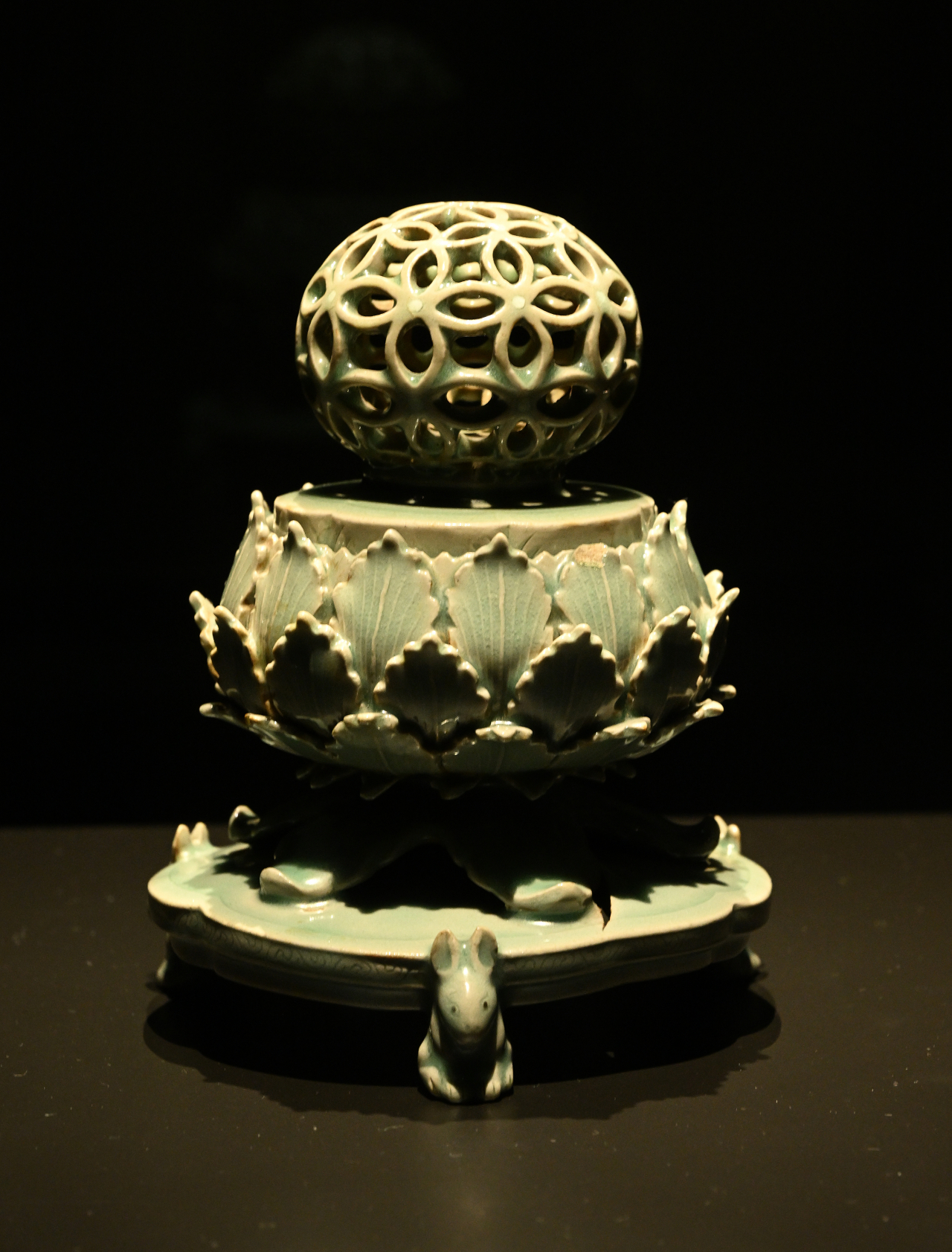 |
A celadon incense burner with openwork design (Im Se-jun/ The Korea Herald) |
The evolution of Korean ceramics reflects the evolution of society itself, having developed through three main historical periods, each with its own unique characteristics. From the humble earthenware of the Three Kingdoms period to the Goryeo era's celadon and the refined white porcelain of the Joseon era, Korean ceramics have captivated art historians and art enthusiasts alike.
The late William Bowyer Honey, a renowned ceramics specialist, noted in his book, "The Ceramic Art of China and Other Countries of the Far East (1945)," "The best Korean wares are not only original. They are the most gracious and unaffected pottery ever made. They have every virtue that pottery can have."
The making of Korean ceramics became more sophisticated over time. With better control of iron and oxygen, the color gradually turned clearer and more transparent -- from brown and yellow finishes to bluish jade and then to white. Finding the right type of soil or taking out much of the iron in the clay and glaze was a key aspect of such advancement.
One of the most notable achievements of Korean ceramics is the celadon of the Goryeo Kingdom (918-1392).
"Cheongja" of the Goryeo era were made with a type of clay and glaze that contained about two to three percent of the iron in their total composition. In the Joseon era, "baekja" contained one percent or less iron in their composition.
The National Museum of Korea's newly renovated celadon room, which opened last November, showcases some 250 celadon pieces from the Goryeo Kingdom, including 12 National Treasures and 12 Treasures.
Among them, you can find a celadon incense burner with openwork geometric design, designated as National Treasure No. 95.
"The piece is housed in the ‘Goryeo Bisaek’ section within the celadon room, along with 17 other celadon objects that are known for their outstanding artistry," Kang Kyeong-nam, a researcher specializing in Goryeo celadon, told The Korea Herald. "It has a unique grayish-blue glaze with a subtle gloss flowing through the curves. We tried our best to ensure that the lighting did not distort the celadon's original color."
The incense burner, which stands at 15.3 centimeters tall, has a spherical lid decorated with an openwork design of interlocking circles. Its pedestal measures at 11.2 centimeters in diameter.
Three rabbits hold up the raised pedestal with their backs, on which rests the incense burner with a lotus flower-shaped bowl. The leaves of the lotus flower are sculpted with a mold and the petals feature delicate incisions of fine lines. The spherical lid created with openwork of interlocking circles, an ancient symbol of Buddhism, serves as a vent from which the incense smoke drifts out into the air.
The shape of the incense burner, wide at the top and narrowing toward the foot, is called a "maebyeong-type" in Korean. The expression of a lotus flower just about to bloom with layers of petals adds liveliness and balance to the work.
Various techniques used to decorate celadon vessels are incorporated in this single piece, such as incision, embossing, painting inlay, openwork, applique and sculpting of natural forms.
The piece was produced in the 12th century, when the art of Goryeo celadon reached its zenith. This golden age lasted until the early 13th century.
 |
A close-up view of one of the three rabbits that hold the pedestal of the celadon incense burner on their back (Im Se-jun/ The Korea Herald) |
Goryeo celadon pieces were used for a variety of daily purposes -- as tea cups, liquor bottles, flower vases, perfume containers, brush holders, water droppers for painting and even roof tiles.
"Although cheongja (celadon) have been discovered at different times and places, we can reasonably assume the usage of cheongja from the writings of scholars, such as government official Yi Gyu-bo's (1168-1241) poems," Kang said.
In his book "Donggukisanggukjip," Yi, a Goryeo official, describes the beauty of Goryeo celadon as "glowing like a marble in vivid blue hue," while offering a drink to his pupil. He praises the craftsmanship of potters for creating pieces that are robust in quality while maintaining their beauty.
The demand for Goryeo celadon increased as it became known to neighboring countries including China, Mongolia and Japan. This resulted in the production of low quality celadon with a focus on practicality.
As the production volume increased, the unique lustrous hue of Goryeo celadon became lost.
Moreover, since the potters were trained under rigid apprenticeship, as time passed, fewer people possessed the high skills required for creating Goryeo celadon's original color.
Making celadon takes a considerable amount of time. But on top of that, the work requires potters to be experienced in temperature and humidity control, which takes much devotion.
"The temperature inside the kiln is kept between 1,200 to 1,250 degrees Celsius for Goryeo celadon. This high temperature is usually maintained for two to three days depending on the size and depth of the kiln, in order to achieve the right color," Kang said.
Goryeo celadon is not just a work of art, but a testament to the skill and devotion of Goryeo potters.
This is the third in a series of articles introducing well-known cultural artifacts from different periods in Korean history. -- Ed.






![[Today’s K-pop] Blackpink’s Jennie, Lisa invited to Coachella as solo acts](http://res.heraldm.com/phpwas/restmb_idxmake.php?idx=644&simg=/content/image/2024/11/21/20241121050099_0.jpg)
